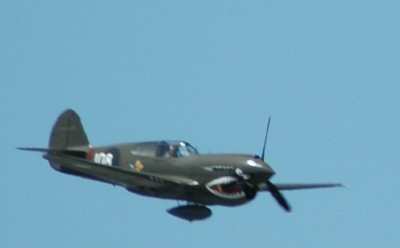Witnesses Describe Entry Into Spin
The National Transportation Safety Board has issued its
preliminary report into the August 5, 2009 downing of a World War
II-vintage Curtiss-Wright P-40 fighter off the coast of upstate New
York.
As ANN reported, the crash claimed the life of
the only person onboard, veteran airshow pilot and vintage aircraft
enthusiast Robert Baranaskas.

The unedited NTSB report is presented below.
NTSB Identification: ERA09LA233
14 CFR Part 91: General Aviation
Accident occurred Sunday, April 05, 2009 in Mastic Beach, NY
Aircraft: CURTISS WRIGHT P-40N, registration: N740RB
Injuries: 1 Fatal.
This is preliminary information,
subject to change, and may contain errors. Any errors in this
report will be corrected when the final report has been
completed.
On April 5, 2009, at 1325 eastern
daylight time, a Curtiss Wright P-40N, N740RB, collided with the
Atlantic Ocean 1/4 mile off the shore of Mastic Beach, New York.
The certificated commercial pilot was fatally injured. Visual
meteorological conditions prevailed, and no flight plan was filed
for the personal flight that departed Brookhaven Airport, (HWV),
Shirley, New York, at 1309. The aerobatic flight was conducted
under the provisions of 14 Code of Federal Regulations Part 91.
In a written statement, the pilot's
son said that he and his father were an airshow "team" and that the
purpose of the flight was to practice aerobatics, and that he would
act as a "safety guide" from the beach with a handheld radio. The
pilot's son stated that all communications with the accident
airplane were "normal."
 The airplane entered a "half Cuban eight" maneuver at an
estimated 250 to 260 mph and when the airplane was "in the middle
of the Cuban eight it went into a spin." The pilot's son estimated
the airplane had slowed to 100 to 120 mph, which was "too slow,"
when the airplane entered the spin, and lacked the altitude to
recover before crashing into the sea.
The airplane entered a "half Cuban eight" maneuver at an
estimated 250 to 260 mph and when the airplane was "in the middle
of the Cuban eight it went into a spin." The pilot's son estimated
the airplane had slowed to 100 to 120 mph, which was "too slow,"
when the airplane entered the spin, and lacked the altitude to
recover before crashing into the sea.
In a written statement, a former Army
pilot described a similar sequence of events, and stated that he
thought the pilot was attempting an "Immelman" turn and added, "I
knew he was in trouble when he didn't complete the Immelman turn
and went off on one wing. The plane made 4 to 5 revolutions and
augured into the ocean." The witness stated that no parts departed
the airplane at anytime during the flight or accident sequence.
A third witness stated that he and his
friends watched the airplane from the beach as it performed "tight
turns and then a flip." He said, "The airplane flew upward, then
turned down and started to spiral toward the water."
A fourth witness stated, "It appeared
that the aircraft was performing a loop. At the apex of the loop,
the aircraft dropped straight down nose first."
A review of Federal Aviation
Administration (FAA) records revealed the pilot held a commercial
pilot certificate with ratings for airplane single engine land,
multi-engine land, and instrument airplane. The pilot was issued a
second-class medical certificate on January 14, 2009. The pilot
reported 2,300 hours on that date.
According to FAA records, the airplane
was manufactured in 1944. The airplane logbooks were not yet
recovered.
At 1256, the weather reported at HWV,
5 miles north of the accident site, included clear skies, 10 miles
visibility, and wind from 310 degrees at 13 knots, gusting to 26
knots. The temperature was 13 degrees Celsius (C), and the dew
point was -1 degrees C.
The wreckage was observed by an FAA
inspector from a boat, as it remained submerged. The wreckage had
not yet been recovered, nor examined.
The pilot was issued an FAA
Certificate of Waiver or Authorization (FAA Form 711-1) to perform
aerobatics in a "box" of defined dimensions off the coast of Mastic
Beach, on April 3, 2009.
In a written statement, the FAA
inspector stated that the pilot failed to file a Notice to Airman,
and did not notify the controlling air traffic facility to activate
the box prior to beginning aerobatic activity, as required by the
Certificate of Waiver.
 Sierra Space Repositions Dream Chaser for First Mission
Sierra Space Repositions Dream Chaser for First Mission ANN's Daily Aero-Term (05.10.24): Takeoff Roll
ANN's Daily Aero-Term (05.10.24): Takeoff Roll Aero-News: Quote of the Day (05.10.24)
Aero-News: Quote of the Day (05.10.24) Aero-News: Quote of the Day (05.11.24)
Aero-News: Quote of the Day (05.11.24) ANN's Daily Aero-Term (05.11.24): IDENT Feature
ANN's Daily Aero-Term (05.11.24): IDENT Feature




